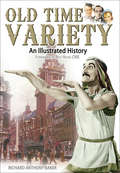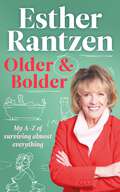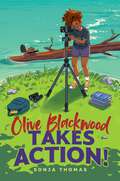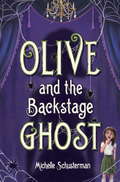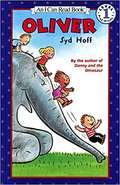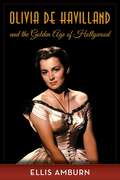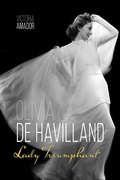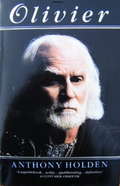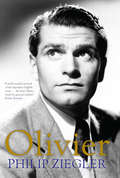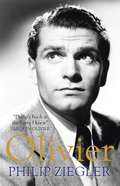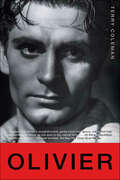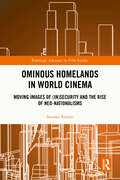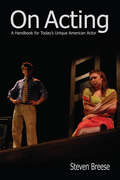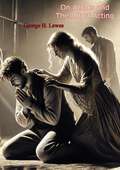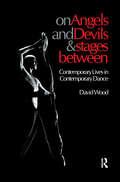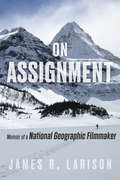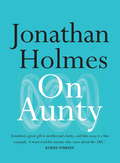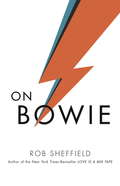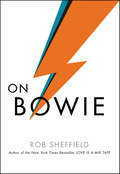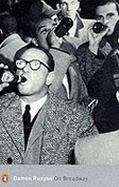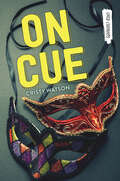- Table View
- List View
Old Time Variety: An Illustrated History
by Richard Anthony Baker&“An illustrated history of good old-fashioned entertainment from names like Tessie O&’Shea, George Formby, and the early days of Bruce Forsyth.&” —Yours As one of the richest sources of diversion for the people of Britain between the end of the First World War and the 1960s, the variety theater emerged from the embers of music hall, a vulgar and rambunctious entertainment that had held the working classes in thrall since the 1840s. Music hall bosses decided they would do better business if a man going to theaters on his own could take his wife and children with him, knowing they would see or hear nothing that would scandalize them. So variety, a gentler, less red-blooded entertainment was gradually established. At the top of the profession were Gracie Fields, a peerless singer and comedienne, and Max Miller, a comic who was renowned for being risqué, but who, in fact, never cracked a dirty joke. They were supported by acts that matched the word variety: ventriloquists, drag artists, animal acts, acrobats, jugglers, magicians and many more. But the variety theater was constantly under threat, first from revue, then radio, the cinema, girlie shows, the birth of rock &’n&’ roll and finally television. By the end of the 1950s, the variety business seemed to have given up, but the recent and extraordinary popularity of talent shows on television has proved the public appetite is still there. Variety could be about to start all over again. &“A priceless record of the people who entertained several generations between the wars and, for a brief time, after WWII . . . thoroughly entertaining.&” —Books Monthly
Older and Bolder: My A-Z of surviving almost everything
by Esther RantzenBe bolder as you grow older, and make sure you float above any challenges that threaten to overwhelm you. Multi-award-winning broadcaster, founder of Childline and The Silver Line, campaigner, mother, grandmother and joyous trailblazer of our times, Dame Esther Rantzen dazzles in the glory of getting older and ever bolder.And now in this energising A-Z, she time-travels through her most signi?cant memories, from meeting Princess Diana to creating a national outrage with a mischievous short ?lm about a driving dog, and re?ects with candour and humour on the life lessons she's learned, revealing the hints, hacks and personal philosophies that have been her secrets to surviving almost everything.We may not all achieve what Dame Esther has, but here we can soak up her wisdom, laugh with her, learn from her, embrace the passing years and march boldly on.
Olive Blackwood Takes Action!
by Sonja ThomasAn anxious aspiring filmmaker bands together with an unlikely friend group to protect their beloved state animal in this heartwarming contemporary middle grade novel perfect for fans of Jamie Sumner and Erin Entrada Kelly.Twelve-year-old Olive Blackwood&’s dream is to direct blockbuster fantasy movies, just like her dad wanted to before he died. She decides to apply to the highly competitive Rose City Summer Film Camp with the help of her best friend, Kayla. But Olive isn&’t sure how she can cast the movie when the mere thought of talking to a stranger makes her nervous. Then a surprise project in Olive&’s film class presents her best chance at going to Rose City: the group who makes the best documentary trailer will receive a recommendation to the elite program! But Olive&’s hopes are quickly dashed when she&’s paired with the two worst students in class: loud Jo Willems has a flashy style of dressing just as intimidating as their outspoken opinions and David Moore is even quieter than Olive, fading into the background. It seems impossible for the three of them to find enough common ground to produce something noteworthy. When Olive stumbles across an old lady chasing a beaver with a frying pan, she&’s disturbed to discover it&’s legal to kill beavers in Oregon—which has the animal on the state flag! Olive posts the video she took of the incident, and it goes viral. She wants to raise more awareness, and if she uses her documentary to do it, she could even get the coveted Rose City recommendation at the same time. With the help of unexpected friendship, counseling, and a little everyday magic, can Olive make her voice be heard?
Olive and the Backstage Ghost
by Michelle SchustermanA ghost story with a literary heart for fans of Neil Gaiman’s Coraline and The Graveyard Book. Theater kids and ghost-story readers alike will find new meaning in the term stage fright. All great theaters have their ghosts. . . . After Olive Preiss freezes during a theater camp audition, she flees in despair. She finds herself at Maudeville, a beautiful old theater that she’s never noticed before. She enters, goes onstage, and sings her song. “Thank you for that lovely audition, darling,” comes a voice from the shadows. “I believe I have just the part for you.” Olive is thrilled to work with Maude Devore, the glamorous actress who owns the theater, and her eclectic cast of misfits. Yet gradually there are signs that Maudeville isn’t exactly what it seems. Sometimes—just for a moment!—it feels wrong. As opening day approaches, Olive’s doubts and fears grow. But no matter what, this show must go on . . . and on . . . and on. . . . “Equal parts heart and bone-deep creepiness.” —Claire Legrand, author of The Cavendish Home for Boys and Girls
Oliver (I Can Read Level 1)
by Syd HoffOliver has always wanted to be a dancing elephant, but what will he do when he discovers the circus already has enough elephants? Beginning readers will laugh out loud as they follow Oliver's adventures and find out how this elephant of unique charm and talent finally achieves his dream.
Olivia de Havilland and the Golden Age of Hollywood
by Ellis AmburnThis is classic Hollywood history as told through the life and career of one of its mosticonic actresses. The book benefits tremendously from the author's meeting with Olivia de Havilland after he was assigned to handle her projected memoir at the Delacorte Press in 1973. Amburn also knew many of the key figures in her life and career, a veritable pantheon of Hollywood royalty from the 30s, 40s, and 50s: Jimmy Stewart, George Cukor, and David O. Selznick, and he was an editor at William Morrow when the company published the autobiography of de Havilland's difficult sister Joan Fontaine.Superbly researched and full of delicious anecdotes about Clark Gable, John Huston, Vivien Leigh, Laurence Olivier, Montgomery Clift, Errol Flynn, David Niven, and Bette Davis--particularly the bloody, bone-crunching fistfight Flynn and Huston waged over Olivia--this book not only profiles one of the finest actresses of her time, but also the culture of the film industry's Golden Age.It details de Havilland's relationships with the men who sought her--Howard Hughes, Jimmy Stewart, Errol Flynn, John F. Kennedy, Burgess Meredith, and John Huston, as well as her friendships with Grace Kelly, British Prime Minister Edward Heath, Ronald Reagan, Victor Fleming, and Ingrid Bergman.Here, too, are the fabulous and often surprising back stories of her 49 films, including Gone With the Wind, The Adventures of Robin Hood, The Snake Pit, Hush . . . Hush, Sweet Charlotte, and the two for which she won Oscars, The Heiress and To Each His Own. The account of the filming of Gone With the Wind is unique in that the author interviewed many of the people involved in the epic making of this masterpiece as Lois Dwight Cole, who discovered the novel, producer David O. Selznick, director George Cukor, agents Kay Brown and Annie Laurie Williams, Radie Harris, Vivien Leigh's closest friend in the press, and both Edie Goetz and Irene Mayer Selznick, daughters of Louis B. Mayer, head of MGM, the studio that funded, released, and ended up owning Gone With the Wind.Also included in this biography are Olivia's adventures with Bette Davis. They appeared together in four movies and Davis tried to destroy her, but Olivia stood up to Davis as no other actress had ever dared to do. She won Davis's respect, and by the time they made their biggest hit, Hush . . . Hush, Sweet Charlotte, a lasting friendship had blossomed. Undertaking a joint national publicity tour, they attracted mobs of boisterous fans and, in private, reminisced about the Golden Age of movies, evaluated the current crop of stars, and exchanged observations about love goddesses, nudity, and parenthood.
Olivia de Havilland: Lady Triumphant (Screen Classics)
by Victoria Amador&“There is much more to de Havilland&’s story than her role as Melanie Wilkes, and it&’s all here . . . a treat for film fans&” (Booklist).Two-time Academy Award winner Olivia de Havilland is best known for her role as Melanie Wilkes in Gone with the Wind. She often inhabited characters who were delicate, elegant, and refined; yet at the same time, she was a survivor with a fierce desire to direct her own destiny on and off the screen. She fought and won a lawsuit against Warner Bros. over a contract dispute that changed the studio contract system forever. She is also noted for her long feud with her sister, fellow actress Joan Fontaine—a feud that lasted from 1975 until Fontaine&’s death in 2013.Victoria Amador draws on extensive interviews and forty years of personal correspondence with de Havilland to present an in-depth look at her life and career.Amador begins with de Havilland&’s childhood—she was born in Japan in 1916 to affluent British parents who had aspirations of success and fortune in faraway countries—and her theatrical ambitions at a young age. The book then follows her career as she skyrocketed to star status, becoming one of the most well-known starlets in Tinseltown. Readers are given an inside look at her love affairs with iconic cinema figures such as James Stewart and John Huston, and her onscreen partnership with Errol Flynn, with whom she starred in The Adventures of Robin Hood and Dodge City. After she moved to Europe, de Havilland became the first woman to serve as the president of the Cannes Film Festival in 1965, and remained active in film and television for another two decades.Olivia de Havilland: Lady Triumphant is a tribute to one of Hollywood&’s greatest legends, tracing her evolution from a gentle heroine to a strong-willed, respected, and admired artist.
Olivier
by Anthony HoldenThis is a biography of Laurence Olivier, the actor, director, impresario, founder of the National Theatre, Oscar-winning film star and the first peer in the history of the profession.
Olivier
by Anthony HoldenThis is a biography of Laurence Olivier, the actor, director, impresario, founder of the National Theatre, Oscar-winning film star and the first peer in the history of the profession.
Olivier
by Philip ZieglerA finalist for the Sheridan Morley Prize that has been called "probably the best Olivier book for general readers" (Kirkus Reviews), Philip Ziegler's Olivier provides an incredibly accessible and comprehensive portrait of this Hollywood superstar, Oscar-winning director, and one who is considered the greatest stage actor of the twentieth century. The era abounded in great actors--Gielgud, Richardson, Guinness, Burton, O'Toole - but none could challenge Laurence Olivier's range and power. By the 1940s he had achieved international stardom. His affair with Vivien Leigh led to a marriage as glamorous and as tragic as any in Hollywood history. He was as accomplished a director as he was a leading man: his three Shakespearian adaptations are among the most memorable ever filmed. And yet, at the height of his fame, he accepted what was no more than an administrator's wage to become the founding Director of the National Theatre. In 2013 the theatre celebrates its fiftieth anniversary; without Olivier's leadership it would never have achieved the status that it enjoys today. Off-stage, Olivier was the most extravagant of characters: generous, yet almost insanely jealous of those few contemporaries whom he deemed to be his rivals; charming but with a ferocious temper. With access to more than fifty hours of candid, unpublished interviews, Ziegler ensures that Olivier's true character--at its most undisguised--shines through as never before.
Olivier
by Philip ZieglerHollywood superstar; Oscar-winning director; greatest stage actor of the twentieth century. The era abounded in great actors - Gielgud, Richardson, Guinness, Burton, O'Toole - but none could challenge Laurence Olivier's range and power. By the 1940s he had achieved international stardom. His affair with Vivien Leigh led to a marriage as glamorous and as tragic as any in Hollywood history. He was as accomplished a director as he was a leading man: his three Shakespearian adaptations are among the most memorable ever filmed. And yet, at the height of his fame, he accepted what was no more than an administrator's wage to become the founding Director of the National Theatre. In 2013 the theatre celebrates its fiftieth anniversary; without Olivier's leadership it would never have achieved the status that it enjoys today. Off-stage, Olivier was the most extravagant of characters: generous, yet almost insanely jealous of those few contemporaries whom he deemed to be his rivals; charming but with a ferocious temper. With access to more than fifty hours of candid, unpublished interviews, Philip Ziegler ensures that Olivier's true character - at its most undisguised - shines through as never before.
Olivier
by Philip ZieglerHollywood superstar; Oscar-winning director; greatest stage actor of the twentieth century. The era abounded in great actors - Gielgud, Richardson, Guinness, Burton, O'Toole - but none could challenge Laurence Olivier's range and power. By the 1940s he had achieved international stardom. His affair with Vivien Leigh led to a marriage as glamorous and as tragic as any in Hollywood history. He was as accomplished a director as he was a leading man: his three Shakespearian adaptations are among the most memorable ever filmed. And yet, at the height of his fame, he accepted what was no more than an administrator's wage to become the founding Director of the National Theatre. In 2013 the theatre celebrates its fiftieth anniversary; without Olivier's leadership it would never have achieved the status that it enjoys today. Off-stage, Olivier was the most extravagant of characters: generous, yet almost insanely jealous of those few contemporaries whom he deemed to be his rivals; charming but with a ferocious temper. With access to more than fifty hours of candid, unpublished interviews, Philip Ziegler ensures that Olivier's true character - at its most undisguised - shines through as never before.
Olivier: The Story Of A Great Theatre From Kean To Olivier To Spacey
by Terry ColemanBased on exclusive, unprecedented access, the definitive biography of Sir Laurence Olivier, the dashing, self-invented Englishman who became the greatest actor of the twentieth centurySir Laurence Olivier met everyone, knew everyone, and played every role in existence. But Olivier was as elusive in life as he was on the stage, a bold and practiced pretender who changed names, altered his identity, and defied characterization. In this mesmerizing book, acclaimed biographer Terry Coleman draws for the first time on the vast archive of Olivier's private papers and correspondence, and those of his family, finally uncovering the history and the private self that Olivier worked so masterfully all his life to obscure. Beginning with the death of his mother at age eleven, Olivier was defined throughout his life by a passionate devotion to the women closest to him. Acting and sex were for him inseparable: through famous romances with Vivien Leigh and Joan Plowright and countless trysts with lesser-known mistresses, these relationships were constantly entangled with his stage work, each feeding the other and driving Olivier to greater heights. And the heights were great: at every step he was surrounded by the foremost celebrities of the time, on both sides of the Atlantic—Richard Burton, Greta Garbo, William Wyler, Katharine Hepburn. The list is as long as it is dazzling.Here is the first comprehensive account of the man whose autobiography, written late in his life, told only a small part of the story. In Olivier, Coleman uncovers the origins of Olivier's genius and reveals the methods of the century's most fascinating performer.
Ominous Homelands in World Cinema: Moving Images of (In)Security and the Rise of Neo-Nationalisms (Routledge Advances in Film Studies)
by Susana AraújoOminous Homelands in World Cinema examines contemporary films from a range of national settings that expose and critically engage with representations of “Homeland” – a term that resurfaced with renewed intensity in the United States through the establishment of the Department of Homeland Security after 9/11 and gained traction across Europe, contributing to the formation of new securitarian configurations whose impact has resonated globally.By drawing on contemporary films from different national contexts, and relating these with emerging political discourses, this book explores some of the new meanings and images associated with ideas of home and land. The analysis also traces how notions and representations of “Homeland” in popular culture have increasingly become infused with themes of security and control, not only linked to terrorism but also progressively connected to a number of other global processes such as the so-called “refugee crisis,” the emergence of new geopolitical powers, wars and the rise of authoritarian leaders and nationalistic movements in different parts of the world.This book will be of interest to students and scholars in media and film studies, American studies, cultural studies, critical security studies, international relations, contemporary history and global studies.
On Acting: A Handbook for Today's Unique American Actor
by Steven BreeseTo support a new generation of actors/acting teachers by coupling fresh ideas and new approaches with the best proven methods and practices. On Acting is written primarily for the contemporary American actor. It strives to address the acting process with an eye toward the performance culture and requirements that exist today. It is a book for the new twenty-first century artist—the serious practical artist who seeks to pursue a career that is both fulfilling and viable.The text features a balance of philosophy, practical advice, anecdotal evidence/experiences and a wide variety of acting exercises/activities. Also included is the short Steven Breese play "Run. Run. Run Away" and an example of a scene score from that play.
On Actors and The Art of Acting [Second Edition]
by George H. LewesDelve into the captivating world of theater with George H. Lewes' insightful and eloquent work, "On Actors and The Art of Acting." This timeless book offers a profound exploration of the craft of acting and the unique qualities that distinguish great actors, making it an essential read for theater enthusiasts, students, and practitioners.George H. Lewes, a prominent 19th-century philosopher, critic, and theater aficionado, brings his deep understanding of the performing arts to this comprehensive study. "On Actors and The Art of Acting" examines the techniques, challenges, and triumphs of acting, providing a detailed analysis of what it takes to excel on stage. Lewes’ reflections are grounded in his extensive experience and keen observations of some of the most renowned actors of his time.The book is divided into insightful essays that cover various aspects of the acting profession. Lewes discusses the importance of emotional authenticity, the physicality of performance, and the intellectual rigor required to interpret and inhabit a character. He also explores the dynamics between actors and audiences, shedding light on the symbiotic relationship that breathes life into theatrical performances.One of the highlights of "On Actors and The Art of Acting" is Lewes’ vivid portraits of famous actors and actresses, including contemporaries like Edmund Kean, William Charles Macready, and Sarah Siddons. Through these case studies, he illustrates the diverse approaches and distinctive styles that contribute to their lasting legacy in the theater world."On Actors and The Art of Acting" is an invaluable resource for anyone seeking to deepen their appreciation of theatrical performance or to gain insights into the art and craft of acting. George H. Lewes' thoughtful analysis and rich descriptions make this book a timeless tribute to the enduring magic of the theater.
On Angels and Devils and Stages Between: Contemporary Lives in Contemporary Dance (Choreography and Dance Studies Series #Vol. 19)
by David WoodFirst published in 1999. Routledge is an imprint of Taylor & Francis, an informa company.
On Animation: The Director's Perspective Vol 1
by Ron DiamondBe a fly on the wall as industry leaders Bill Kroyer and Tom Sito take us through insightful face-to-face interviews, revealing, in these two volumes, the journeys of 23 world-class directors as they candidly share their experiences and personal views on the process of making feature animated films. The interviews were produced and edited by Ron Diamond. Your job is not to be the one with the answers. You should be the one that gets the answers. That’s your job. You need to make friends and get to know your crew. These folks are your talent, your bag of tricks. And that’s where you’re going to find answers to the big problems - Andrew Stanton It’s hard. Yet the pain you go through to get what you need for your film enriches you, and it enriches the film. – Brenda Chapman Frank and Ollie always used to say that great character animation contains movement that is generated by the character’s thought process. It can’t be plain movement. – John Lasseter The beauty of clay is that it doesn’t have to be too polished, or too smooth and sophisticated. You don’t want it to be mechanical and lifeless. – Nick Park The good thing about animation is that tape is very cheap. Let the actor try things. This is where animation gets to play with spontaneity. You want to capture that line as it has never been said before. And, most likely, if you asked the actor to do it again, he or she just can’t repeat that exact performance. But you got it. – Ron Clements
On Animation: The Director's Perspective Vol 2
by Ron DiamondOn Animation: The Director's Perspective is a collection of interviews with 23 animated feature-film directors. These extensive interviews were conducted over the past several years by filmmakers and educators (and peers to the directors interviews) Tom Sito and Bill Kroyer. Interviews cover in-depth discussion of each director's career -- focusing on their creative development, their films, lesson learned and advice. The interviews were edited and produced by Ron Diamond.Key FeaturesInterviews with the greatest living legends in animationOffers profound insight into the creative process of these giantsGrants advice and lessons for inspiring animators
On Assignment: Memoir of a National Geographic Filmmaker
by James R. LarisonAn exciting adventure story with personal drama and high stakes, as well as a glimpse behind the scenes of the highly regarded National Geographic brand Jim and Elaine Larison spent years studying, exploring, and living in wild places, making more than thirty environmental films, most for the National Geographic Society. These films won more than forty international awards from leading environmental and broadcast organizations. This memoir tells the story behind the adventure and describes the rather substantial personal costs of this career. While shooting film in Alaska, Jim Larison narrowly survived a devastating airplane crash in the Bering Sea. Later, while filming on the Great Barrier Reef, the Larisons fought off an aggressive twelve-foot tiger shark. Midway through their careers, the Larisons were nearly swept to their deaths by an icefall while filming on Mount Robson. A thrilling adventure story, full of risk and personal conflict, On Assignment is also a touching look at the tender bonds that held the married couple together while they struggled to complete their many film assignments. The Larisons were changed by what they saw and what they captured on film: the destruction of forests, the death of coral reefs, and global warming.In the beginning, the Larisons wanted nothing more than to spend time in the wilderness. By the end, they were fighting for its very survival.
On Aunty
by Jonathan HolmesAustralia's public broadcaster, 'Aunty', is about to turn 90, yet your ABC has seldom been in this much trouble: budget cuts, ferocious political pressure, sagging staff morale, leadership chaos and hostile commercial rivals.Meanwhile audiences are deserting broadcast TV and radio. What is the ABC's place in this era of media disruption? Can it reach a younger audience on new platforms while still satisfying its loyal fans?
On Bowie
by Rob SheffieldOn Bowie is a thoughtful and loving meditation on the life of the late David Bowie that explores his creative legacy and the enduring and mutual connection he enjoyed with his fansInnovative. Pioneering. Brave. Until his death in January 2016, David Bowie created art that not only pushed boundaries, but helped fans understand themselves and view the world from fantastic new perspectives.When the shocking news of his death on January 10, 2016 broke, the outpouring of grief and adulation was immediate and ongoing. Fans around the world and across generations paid homage to this brilliant, innovate, ever-evolving artist who both shaped and embodied our times.In this concise and penetrating book, highly-regarded Rolling Stone critic, bestselling author, and lifelong Bowie fan Rob Sheffield shares his own feelings about the passing of this icon and explains why Bowie's death has elicited such an unprecedented emotional outpouring from so many.
On Bowie
by Rob SheffieldFrom the New York Times bestselling author of Love Is a Mix Tape, a thoughtful and loving meditation on the life of the late David Bowie that explores his creative legacy and the enduring and mutual connection he enjoyed with his fans.Innovative. Pioneering. Brave. Until his death in January 2016, David Bowie created art that not only pushed boundaries, but helped fans understand themselves and view the world from fantastic new perspectives.When the shocking news of his death on January 10, 2016 broke, the outpouring of grief and adulation was immediate and ongoing. Fans around the world and across generations paid homage to this brilliant, innovate, ever evolving artist who both shaped and embodied our times.In this concise and penetrating book, featuring color photographs, highly regarded Rolling Stone critic, bestselling author, and lifelong Bowie fan Rob Sheffield shares his own feelings about the passing of this icon and explains why Bowie’s death has elicited such an unprecedented emotional outpouring from so many lives.
On Broadway: Containing All the Stories from More Than Somewhat, Furthermore, Take It Easy
by Damon RunyonThis is a collection of the stories from Damon Runyon who presented the 1950s world of guys and dolls on Broadway. This book contains all the stories from More Than Somewhat, Furthermore, and Take It Easy.
On Cue (Orca Currents)
by Cristy WatsonCan Randi find a way to make it all work out? Randi wants to be an actress and is excited about practicing her craft in drama class. So she is devastated to learn the program has been cut. When her friends put together a successful proposal to have drama class taught as an extracurricular activity, Randi is thrilled—until reality sinks in. Extracurriculars are scheduled after school, and after school, Randi is expected to take care of her brother, Toby, who is autistic. Will Randi have to choose between her passion and her family? This short novel is a high-interest, low-reading level book for middle-grade readers who are building reading skills, want a quick read or say they don’t like to read! The epub edition of this title is fully accessible.
